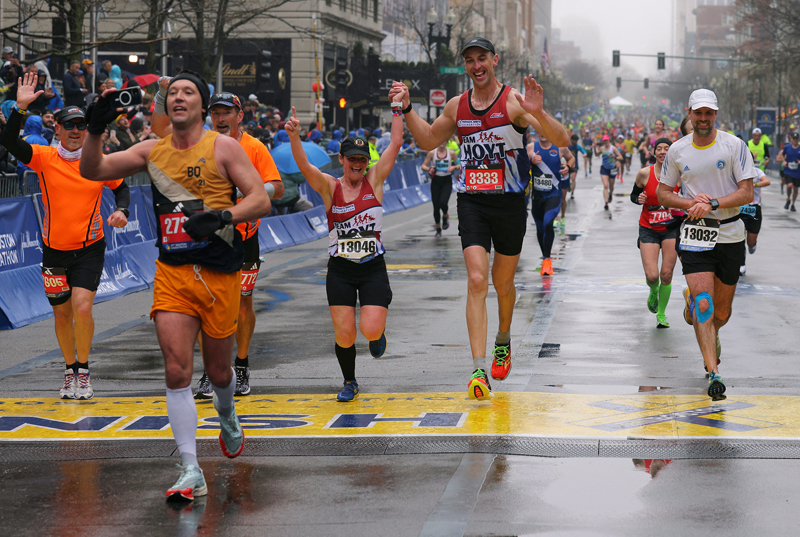Charging up hills boosts leg-muscle strength and improves your running economy, but what about running down hills? If you carry out repeats on a neighbourhood incline, you've got to jog back down the hill before you surge upward again. Does such downhill ambling do anything special for you - aside from giving your knees a good jarring?Of course! As we've mentioned before in Sports Performance Bulletin, downhill running can help prevent leg-muscle soreness, especially in the quadriceps muscles in the front of the thigh. Soreness often results when one's muscles are challenged by a greater-than-normal number of eccentric contractions, in which the muscles attempt to shorten while they are actually being elongated. The 'quads' are notorious soreheads, mainly because gravity pulls the knee downward (ie, produces knee flexion) with every footstrike during the act of running. This flexing stretches out the quads at the exact time they are contracting (attempting to shorten) to prevent excessive knee flexion. The resulting, repetitive strain (which occurs about 90 times per minute per leg) can produce significant quadriceps-muscle damage. If you simply complete your usual volume of training, your quads have already adapted to that amount of strain and ordinarily don't protest too much. However, if you run more miles than you are accustomed to, your quads tend to complain quite loudly. If you have ever boosted your mileage quickly or run a marathon, you know the feeling.
Downhill running actually magnifies this eccentric, 'pulling-apart' stress on the quads, because the leg 'falls' a little farther than normal with each stride. Thus the acceleration of the leg is greater at impact (footstrike), and the forces which produce knee flexion are consequently greater. The quads, of course, are still trying to carry out their yeoman-like work of resisting knee flexion, but the stress on them is much higher. Microscopic tears in the quads' muscle fibres and connective tissues can occur, and considerable soreness can result.
That doesn't mean that downhill running is bad for you, though. In the long run, it is actually good, because those old quads of yours adapt fairly readily. Once they've been exposed to some downhill running, they'll be sore, sure, but if you run downhill a few weeks later, the quads will be considerably 'tougher' - and less apt to get sore. In addition, if - after your downhill exposure - you run longer than usual on the flat, your quads will also be less likely to get hurt. The soreness protection gained from downhill running does seem to carry over to regular efforts.
The six-week factor
In fact, for yet-to-be-explained reasons, the soreness insurance provided by a single bout of downhill running can often last for six weeks or more. Several years ago, scientists at the University of Massachusetts asked 109 individuals to perform two sets of 35 maximal, eccentric contractions of the biceps muscle in the upper part of one arm. Basically, these eccentric contractions consisted of lowering a very heavy weight, which forced the biceps muscles to elongate as the weight was lowered at the same time they were attempting to shorten to stabilize the weight's movement ('Muscle Function after Exercise-Induced Muscle Damage and Rapid Adaptation,' Medicine and Science in Sports and Exercise, vol. 24(5), pp. 512-520, 1992).After this unusual workout, biceps soreness and tightness peaked about two to three days later, and maximal swelling occurred a few days after that. Biceps strength declined immediately after the rigorous session and stayed below-par for 10 days.
However, when the individuals tried the same biceps routine six weeks later (with no intervening biceps training), there was appreciably less soreness and little loss of muscle strength. The biceps muscles were somehow protected from problems as a result of that initial eccentric session.
Interestingly enough, the protection didn't last much longer than six weeks. When a second group of subjects waited 10 weeks after their initial eccentric workout to stress their biceps again, their biceps were thrown into uncontrollable agony and lost most of their strength. What was going on? Why could the biceps 'remember' what happened six weeks before - but not 10 weeks before?
The Massachusetts researchers speculated that a strenuous bout of eccentric exercise 'teaches' the nervous system how to better control and distribute the forces that are acting on particular muscles. In theory, this lessens the strain on individual muscle fibres when eccentric activity tries to 'tear them apart' - and thereby reduces muscle damage and consequent pain. Just as the nervous system can learn to do this, it can also forget, and this forgetting seems to take place after six to 10 weeks.
Australian rats!
Nice theory, but does it really work that way? To check it out, scientists at Monash University in Australia asked 16 laboratory rats to work out on treadmills over a five-day period. Eight of these rats participated only in 'uphill' (inclined) running, while the other eight ran only 'downhill' (declined running). Actual workouts consisted of five-minute work intervals with 1.5-minute recoveries, starting with three work intervals on the first day of training and building up to seven intervals on the fifth day. Running speed during the work intervals was a rather modest 16 metres per minute. After five days, the rats' quadriceps muscles were tested for strength and then biopsied ('Differences in Rat Skeletal Muscles after Incline and Decline Running,' Journal of Applied Physiology, vol. 85(1), pp. 98-104, 1998).A key finding was that the quadriceps muscle cells of the decline-trained rats contained almost 10 per cent more sarcomeres per cell, compared to the quads of the inclined rodents. To understand what sarcomeres are, bear in mind that a muscle cell is a barrel-shaped structure, and each 'barrel' is filled with several hundred to several thousand cylindrical, threadlike structures called myofibrils. To picture this, simply imagine a pipe-shaped structure (the muscle cell) stuffed with countless numbers of small cylindrical wires (the myofibrils). Incidentally, when we say that a muscle cell is shaped like a pipe, we are referring to a section of cylindrical water pipe, not to a pipe used for smoking purposes.
The myofibrils themselves are composed of microscopic, cylindrical compartments laid end to end (picture tiny cylinders or spools glued together at their ends to make one long cylinder). These compartments are called the sarcomeres, and within the sarcomeres are the proteins (filaments) which actually allow muscles to both shorten and elongate. As special filaments slide inward (towards the middles of the sarcomeres), the myofibrils and overall muscle cell shorten, but when the filaments slide outward, the muscle gets longer.As mentioned, downhill running induced the muscle cells to add more sarcomeres to their myofibrils. Why is this increase in number of sarcomeres beneficial, and how can it prevent muscle damage and soreness? Since muscle-cell length itself didn't change significantly as a result of the downhill running, the fact that there were more sarcomeres per muscle cell meant that during eccentric contractions, when the whole muscle cell was elongating, each sarcomere in a downhill-trained muscle would have to elongate less, and thus each sarcomere would be less likely to sustain internal damage
More sarcomeres, less strain
To illustrate this point, let's say that there are two muscle cells which are each one-inch long but must stretch out to two inches during an eccentric action. If one of these muscle cells has 10 sarcomeres, but the other (the downhill-trained fibre) has 20, you can easily see that the 10 sarcomeres would each have to stretch out by one-tenth of an inch to get the cell up to two inches, but the 20 sarcomeres in the other cell would only have to stretch by one-twentieth of an inch each to make the cell long enough. As you can see, there is less strain on the sarcomeres during an eccentric contraction when there are more sarcomeres per myofibril. It's a pretty clever adaptation!Thus, when you run downhill, you're giving your muscle cells a wake-up call to start tacking on more sarcomeres. The increased sarcomere density then reduces stress on the myofibrils and protects you against soreness and damage accruing from future downhill running and very tough or prolonged workouts and races. Since damage is lessened, it also means that you can recover more quickly from very severe training sessions and competitions - and be ready for subsequent quality work more quickly than the poor sap with fewer sarcomeres.
It's no accident that elite Kenyan runners train unceasingly on uphills and downhills - and can carry out more quality training than any other runners in the world (four-time world cross-country champion Paul Tergat is rumoured to carry out five to six red-hot sessions per week when he is training seriously, and Kenyan runners participating in the pre-World-Championship Kenyan national cross-country camp routinely conduct six sizzling sessions per week and 19 weekly workouts overall). Schooled on the severe inclines in the western part of the Rift Valley (or on the Aberdares' harsh slopes if the runner happens to come from central Kenya), the Kenyans' muscles possess a surfeit of sarcomeres and thus are more resistant to the wear-and-tear damage associated with both very fast and very high-volume running.
One shouldn't forget, too, that the presence of more sarcomeres means that muscle contractions can take place more quickly, since each sarcomere has to shorten less to make the overall muscle cell compress (the sliding of the filaments over one another inside sarcomeres takes time; the further they have to slide, the longer it takes to condense a muscle). Using our example of one-inch muscle cells again, but this time saying that they must contract to a length of one-half inch, one can readily see that the 10-sarcomere cell must shorten by .05 inches per sarcomere, while the 20-sarcomere fibre needs to abbreviate by just .025 inches per sarcomere. The combination of quick-contracting, injury-resistant muscles is a trademark of the Kenyan runners.
That's all the more reason to carry out more of your training in hilly areas, but don't forget that there are a few things you should try to do when you run downhill. When you run down slopes, lean forward naturally and comfortably; don't try to lean back with your upper body. Don't let yourself get out of control, but don't stiffen up or resist the hill too much; learn to stay coordinated and balanced as gravity does the work for you. During races, you can actually run faster than your normal race pace on downhills without increasing your effort, oxygen consumption, or heart rate.
And when you train on hills, remember that your uphill surges are enhancing your economy, but your downhill rambles are also having a very positive impact on your running. By running downhill, you are adding sarcomeres to your leg-muscle cells, and those additional sarcomeres should quicken your strides and help keep you free from injury and soreness in the future. That freedom, of course, will allow you to train more consistently and become a much better athlete.
Owen Anderson










